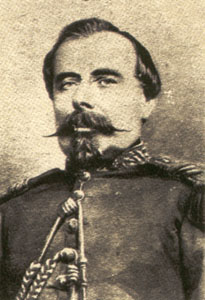- Francisco Bolognesi
Infobox Person
name = Francisco Bolognesi
 |200px
|200px
caption = Peruvian hero during theWar of the Pacific
birth_date = birth date|1816|11|4|mf=y
dead=dead
birth_place =Lima , Lima, PER
death_date = death date and age|1880|6|7|1816|11|4|mf=y
death_place =Arica ,Tarapaca , PERFrancisco Bolognesi Cervantes was a
Peru vian military hero.Early life and education
Francisco Bolognesi was born in
Lima onNovember 4 ,1816 , his paternal family was ofItalian-Peruvian background. He attended the Seminary ofArequipa until he was 16 and then entered into a career in commerce. He was involved with the military in July, 1844, in an action at Carmen Alto, a local district of Arequipa. While offered a position in the military, he elected to remain in civilian life.Military career
However, in 1853, he enlisted and was selected as second in command of a cavalry regiment during a period of tension between Peru and
Bolivia . While no armed conflict with Bolivia ensued, Bolognesi elected to remain in the military and took part in the revolution against then-President Echeñique. After the revolution, Bolognesi was a Lieutenant Colonel on the General Staff.In 1856, Bolognesi commanded the artillery involved in suppressing the revolt of General
Manuel Ignacio de Vivanco , centered in the city of Arequipa and was promoted to Colonel.After several missions to
Europe to help acquire weapons for Peru (especiallyartillery ), Bolognesi returned to Peru in May 1866. He fell afoul of President DonMariano Ignacio Prado and was imprisoned briefly in 1867. After the fall of Prado, Bolognesi returned to military service, commanding various artillery units of the Peruvian army, retiring in 1871 as Commander-in-Chief of the Artillery.War of the Pacific
When the
War of the Pacific began in 1879 betweenChile and the alliance betweenPeru andBolivia , Bolognesi, now 62, rejoined the Peruvian Army and was active in actions against the Chilean forces, including the Battles of Dolores and Tarapacá in November, 1879. In April, 1880, he was placed in command of the Peruvian port ofArica .He commanded the Peruvian forces surrounded in Arica by Chilean troops following the Chilean victory at
Tacna . He organized and led a spirited defense of the port city by about 1,600 men against over 5,300 Chilean troops with extensive naval support.When
Chile an messengers demanded surrender ofArica because of their 3 to 1 numerical superiority, he replied, "Tengo deberes sagrados que cumplir y los cumpliré hasta quemar el último cartucho" ("I have sacred duties to fulfill, and I will fulfill them until I fire the last round"). The expression "hasta quemar el último cartucho" ("Until the last round is fired") has passed into theSpanish language .On June 7, 1880, a Chilean assault took Arica at a cost of 474 troops. Almost 1,000 of the Peruvian defenders, including Colonel Bolognesi, were killed in defense of the town or in subsequent actions against the Peruvian prisoners.
Bolognesi's sons Enrique and Augusto also fought in the War of the Pacific, and died later, during the Battle of San Juan and the
Battle of Miraflores inLima .See also
*
War of the Pacific
*Roque Saenz Peña
*Alfonso Ugarte
*Coronel Bolognesi External links
* [http://www.monografias.com/trabajos13/francisbol/francisbol.shtml Biography of Francisco Bolognesi (in Spanish)]
Wikimedia Foundation. 2010.
